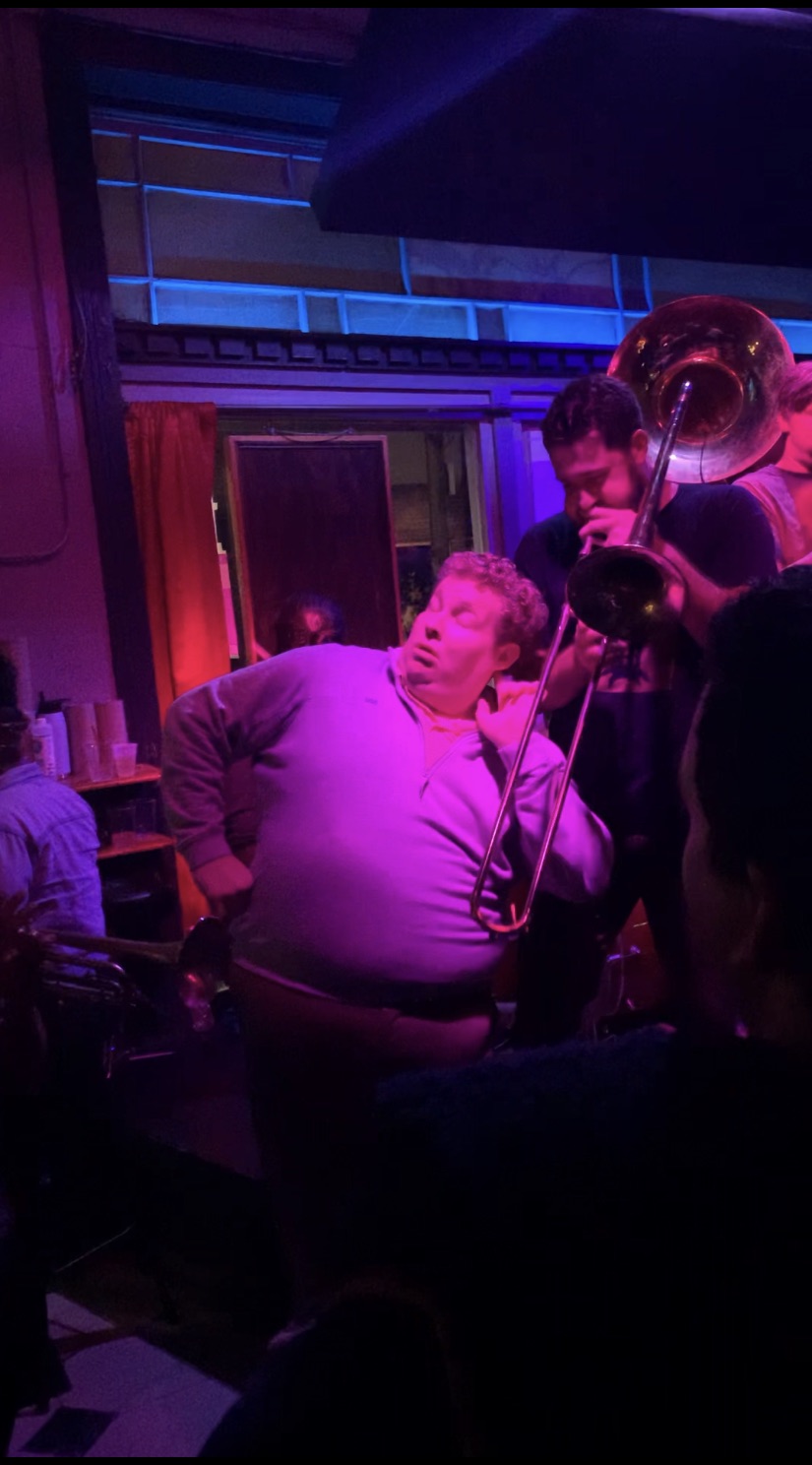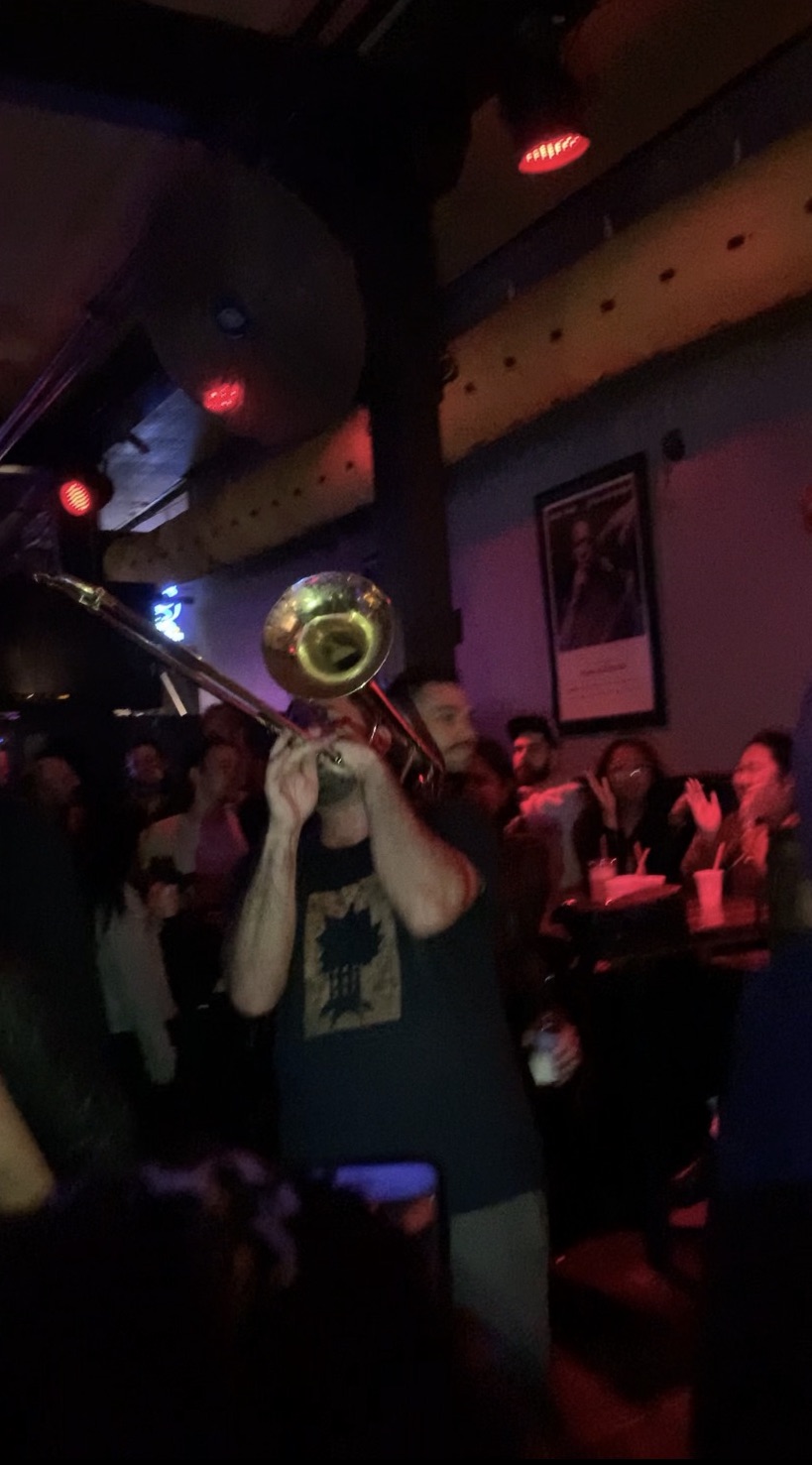In downtown New Orleans on Frenchman Street, there is a special place aptly named The Maison, where people who walk through the frame-only door know that they don’t have to perform; they can just listen unless the music moves them. While this space includes three floors with live music on the first, a DJ on the second, and rave music on the third, the first level remains unparalleled as it rotates brass jazz bands each night. Guests step into a rectangular room where the band is stationed at the head by the front wall of windows and the two bars –one at the side and one in the back – leave just enough space for upward of 20 chairs and tables. The more active audience members stand right in front of the performers to listen and dance, but they don’t realize that by doing this they’re becoming part of the show.
Performer #1:
A man of great stature, perhaps 6’5 and 250 pounds, took center stage on this humid October night. He originally placed himself in the first row but soon moved to stand next to the trombone player and face the audience, signaling that he too should be watched, not only the paid performers. He jolted his shoulders back and forth, folded his arms and did a jazzy shrug, and squatted from side to side.

Performer #1 eggs on the trombone player with his dance moves
The crowd-pleaser was when he did a march in place and held his hand
up to his ear next to the instruments, encouraging the musicians to play harder and the audience to cheer louder.
Humans are drawn to performance because it not only serves as a vehicle to share culture and provide entertainment but because it communicates to the audience in a way that transcends spoken language. As Peter Earl says, “There is something profoundly emotional about living through a concert with a performer who takes his or her art to the limit and emerges triumphant at the end with a perfect or frontier-moving performance”. Humans are able to sense the passion behind the pieces and feel moved by them. A response to this feeling can be one like the man on this night gave: a display of movement that again transcends spoken language and creates a new one that connects music and dance. The audience responds in a third language of hoots and hollers. There is an incredible amount of communication happening in a scenario like this, but it gives us a break from the task of saying traditional words to each other.
Performer #2:A man around 60 years old sat in a white collared button-up nursing a beer in a corner booth that was raised for a clear view of the band. He showed barely any movement with his body, with the exception of a small tapping of the foot or drumming of the fingers. Nevertheless, he was captivated and showed his enjoyment with his presence. He was there before I arrived and stayed beyond the time I left. While in his mind he took a backseat so he could watch instead of performing, his attendance added a new dimension to the overall experience by signifying this was a place welcome to extroverts and introverts alike.
Introverts are known to appreciate more personal space than their extroverted counterparts which leads someone to wonder why an introvert would both enjoy a crowded, noisy space and choose to put themselves in such a scenario. It’s said that “Introverts interact more with their thoughts and emotions at the moment than with the relationships around them.” Listening to music provides a space that is not physically solitary, but mentally. It supplies something for the mind to be entranced with, and that negates the need for conversation or social interaction. Being positioned away from the action but in earshot of the music allows someone to create a bubble in the moment where they can enjoy the irreplicable aspects of a live show by themselves.
Performer #3:
While watching the set my friend leaned over and whispered to me, “Oh my gosh, he was my tour guide!”, in reference to one of the three trombone players – the one with a gray ponytail, faded jeans, and a casual t-shirt. He had moved from the Bay Area to pursue music. To subsidize his lifestyle he daylighted as a city guide, dedicating both his days and nights to providing people with a New Orleans experience. He caters to the 18.5 million visitors the city attracts annually in that way and caters to the locals by performing on Frenchmen, a street that was popularized by them after a tourist takeover of Bourbon Street starting in the 1970s. It is likely that no one else knew about this performer’s second occupation, and this space allowed him to be seen by the audience only as an enthralling, passionate trombonist who was accomplished and respected by those who surrounded him. With such a high volume of tourism and landing a spot to perform on one of the most popular streets downtown, it was curious when a band member stepped off of the stage to make a round of the room with a tip bucket. Presumably playing at a venue with such prestige would make for a substantial paycheck. At many clubs, this is not the case, with bands only taking home a fixed percentage of the nightly bar sales. The average drink costs between $5-10 and the number served increases on the later nights of the week.

A trombone player dazzles the crowd with a solo in the middle of the action
In response to the music clubs on Frenchman street being free of a cover charge, musician Khris Royal says, “Some people think (it) would ruin the street, but so what?… I’d rather play for people who want to listen than to play for people who just want to get drunk.” To find a silver lining in this grossly unequal relationship, it proves the musicians continue to be in the business because of their passion and talent. Similar to the feeling of the city of New Orleans, people are attracted to The Masion because there is no pressure to be anyone but yourself. Different crowds are attracted to the space because they know they can choose to sit, stand, dance, or cheer and none of those actions would be out of place. As a musician who holds the occupation to provide joy for others and gain praise and admiration for themselves, there is no higher compliment than appealing to people across a wide spectrum. It is evident that this place provides a unique sense of comfort and approachability since it brings together the flamboyant giants of the world all the way to the timid retirees.
Works Cited:
Resnick, Brian. “The Scientific Mystery of Why Humans Love Music.” Vox, Vox, 4 Feb. 2016, https://www.vox.com/science-and-health/2016/2/4/10915492/why-do-we-like-music.
Earl, Peter E. “Simon’s Travel Theorem and the Demand for Live Music.” Journal of Economic Psychology, North-Holland, 22 June 2001, https://www.sciencedirect.com/science/article/pii/S016748700100037X.
Interlude. “Why Do Musicians Perform, Anyway?” Interlude, 30 Aug. 2019, https://interlude.hk/perform/.
Douglas, Scott. “Study: Performing Music Gets Us High.” The Atlantic, Atlantic Media Company, 15 Jan. 2013, https://www.theatlantic.com/health/archive/2013/01/study-performing-music-gets-us-high/267138/.
Brasted, Chelsea. “Are Frenchmen Street Musicians Being Fairly Paid?” NOLA.com, 7 June 2017, https://www.nola.com/news/business/article_3db99930-64f1-59cf-9717-4a2f08551be1.html.
“Frenchmen Street Research.” MaCCNO, https://maccno.com/frenchmen-street-research.
Yadegari, Zohre, and Behnoud Alinaghi. “The Effect of Introversion and Extroverts of Individuals in the Socialization of Public Space.” Researchgate, 2020, https://www.researchgate.net/publication/339043494_The_effect_of_introversion_and_Extroverts_of_individuals_in_the_socialization_of_public_space.
 NOLAbeings
Multimedia artist Claire Bangser created NOLAbeings as a portrait-based story project that marries...
NOLAbeings
Multimedia artist Claire Bangser created NOLAbeings as a portrait-based story project that marries...
 Data corner: Adobe Suite (create a PDF, social media graphic, presentation, edit a photo and video
Data corner is where you go to work with analytics and top tech skills. It takes on everything from PERL and SQL to Canva and Sprout Social.
Data corner: Adobe Suite (create a PDF, social media graphic, presentation, edit a photo and video
Data corner is where you go to work with analytics and top tech skills. It takes on everything from PERL and SQL to Canva and Sprout Social.
